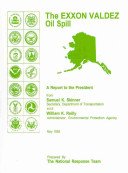
Shortly after midnight on March 24, 1989, the 987-foot tank vessel Exxon Valdez struck Bligh Reef in Prince William Sound, Alaska. What followed was the largest oil spill in U.S. history. The oil slick has spread over 3,000 square miles and onto over 350 miles of beaches in Prince William Sound, one of the most pristine and magnificent natural areas in the country. Experts still are assessing the environmental and economic implications of the incident. The job of cleaning up the spill is under way, and although the initial response proceeded slowly, major steps have been taken.
The very large spill size, the remote location, and the character of the oil all tested spill preparedness and response capabilities. Government and industry plans, individually and collectively, proved to be wholly insufficient to control an oil spill of the magnitude of the Exxon Valdez incident. Initial industry efforts to get equipment on scene were unreasonably slow, and once deployed the equipment could not cope with the spill. Moreover, the various contingency plans did not refer to each other or establish a workable response command hierarchy. This resulted in confusion and delayed the cleanup.
Prepared by the National Response Team, this report was requested by the President and undertaken by Secretary of Transportation Samuel K. Skinner and Environmental Protection Agency Administrator William K. Reilly. The report addresses the preparedness for, the response to, and early lessons learned from the Exxon Valdez incident. The President has also asked Secretary Skinner to coordinate the efforts of all federal agencies involved in the cleanup and Administrator Reilly to coordinate the long-term recovery of the affected areas of the Alaskan environment. These efforts are ongoing.
The report addresses a number of important environmental, energy, economic, and health implications of the incident.